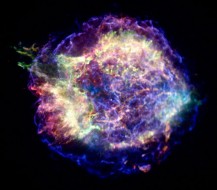How Long Do Stars Live?
A star’s life expectancy depends on its mass. Generally, the more massive the star, the faster it burns up its fuel supply, and the shorter its life. The most massive stars can burn out and explode in a supernova after only a few million years of fusion. A star with a mass like the Sun, on the other hand, can continue fusing hydrogen for about 10 billion years. And if the star is very small, with a mass only a tenth that of the Sun, it can keep fusing hydrogen for up to a trillion years, longer than the current age of the universe. Now onto the question: how do stars die?
How Do Stars Die?

NASA/CXC/MIT/UMass Amherst/M.D.Stage et al.
Answering the question, "How do stars die?" also depends on its mass. The most massive stars quickly exhaust their fuel supply and explode in core-collapse supernovae, some of the most energetic explosions in the universe. A supernova’s radiation can easily (if only briefly) outshine the rest of its host galaxy. The remnant stellar core will form a neutron star or a black hole, depending on how much mass remains. If the core contains between 1.44 and 3 solar masses, that mass will crush into a volume just 10 to 15 miles wide before a quantum mechanical effect known as neutron degeneracy pressure prevents total collapse. The exact upper limit on a neutron star mass isn’t known, but around 3 solar masses, not even neutron degeneracy pressure can combat gravity’s inward crush, and the core collapses to form a black hole.
Curious about black holes? Enter your email and download our FREE Black Holes ebook! As a bonus, you'll also receive our weekly e-newsletter with the latest astronomy news.
[form id="246608822"]
Average stars with up to 1.44 solar masses, such as the Sun, face only a slightly less exotic fate. As they run out of hydrogen to fuse in their cores, they swell into red giant stars before shedding their outer layers. The remnant left behind in these planetary nebulae is a white dwarf star. Like neutron stars, white dwarfs no longer fuse hydrogen into helium, instead depending on degeneracy pressure for support — this time, the electrons are degenerate, packed together and forced into higher energy states, rather than the neutrons.

Anna Mayall/University of Manchester
Left to their own devices, white dwarfs will eventually fade into black dwarfs. No black dwarfs have been observed yet because a white dwarf takes longer than the current age of the universe to fade away. And if the white dwarf is part of a binary system, it may avoid that fate altogether. By accreting matter from its companion star, the white dwarf can explode in a Type Ia supernova, leaving no remnant behind.
The smallest stars in the universe have exceedingly long lives — in fact, none have faced their end yet. Red dwarfs, stars with less than 0.4 solar masses, burn so slowly that they might live to 100 billion years old, much longer than the current age of the universe.
Explore single, multiple, and variable stars in the ultimate Sky Atlas 2000.0 Deluxe Laminated, the star atlas by which all other star atlases are measured.
 0
0








Comments
You must be logged in to post a comment.